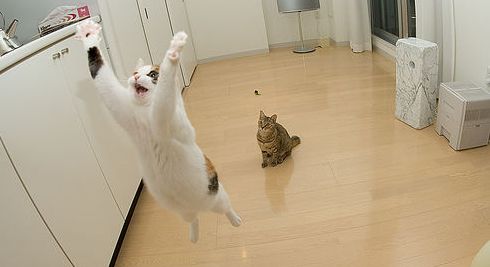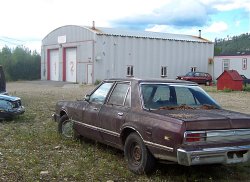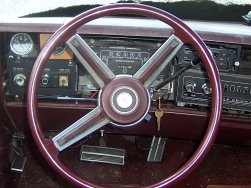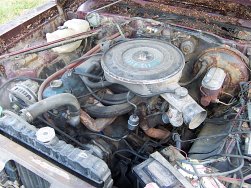jumping cat, from the 17dots blog
I just can’t get enough of this image from the 17dots eMusic blog. The post it comes from relates to an interview with Britt Daniel about Spoon’s new album Ga Ga Ga Ga Ga. So I’m not sure what a jumping cat has to do with it. But everything about the photo is awesome. The way the jumping cat is slightly pudgy; that all four legs are completely outstretched; the other cat sitting on the floor looking stunned; the paw-shadow on the cabinet from the camera flash. And best of all is the expression on the cat’s face, mouth open, eyes sparkling. Every time I look at it, I can’t help but smile.
It’s just the thing when it’s raining outside, the tensions of buying and selling a home are starting to wear thin, and you’re not getting enough quality sleep.
Or maybe that’s just me…
Yesterday we dragged the Volaré to it’s final resting place at the Steese Area Volunteer fire station. They’ll use it to practice vehicle extractions and then send it to the landfill.
I got it for $300 in 1992 when I lived in Portland, Oregon and trusted it enough to drive up to Fairbanks in it. It had 175,000 miles on it when I got it, and the brakes and cooling system needed a lot of work before it was even safe to drive. Over the years I drove it, I replaced almost every part in the engine and power train, finally giving up in 2000 when the transmission died. It has 227,574.9 miles on it and made it through seven Fairbanks winters.
I’ve gotten rid of vehicles before and I never minded seeing them go, but I feel some regret giving up on the Volaré. It was easy to work on, inexpensive to repair, very simple to figure out what was wrong with it, and it was surprisingly fun to drive. Driving down the road looking out over that giant hood felt safe, and the little turn signal indicator lights at the corners of the hood were great. But it got terrible gas mileage, the heater barely worked, the windows iced up in the winter, it required a replacement carburetor every couple years, and I had to put tire chains on to get up and down the hills in winter.
I know it doesn’t look like much, but it got me a long way for very little money, and even though I’m glad it’s not in my yard anymore, I can’t help wishing I could drive it one more time.
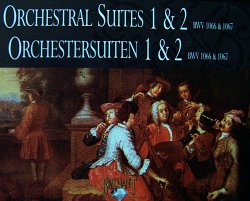
bach: orchestral suites
I’ve been listening to these four pieces much too long without a report, so this one is a bit abbreviated from the format I started with the Brandenburg Concertos. It’s been very hectic around here because we’re looking to buy a house, sell our current house, and move. All within the next month and a half. Even though nothing official has happened yet and we’ve only just started getting our house ready for sale, the whole thing has taken a remarkable toll on us. We’re not sleeping well, stress is high, and we can’t stop thinking about what we should be doing right now. Today I brewed beer and not only did I forget one of the ingredients when I went to the beer store on Thursday, I forgot to add another ingredient while I was brewing. It won’t be quite the same beer I’d planned on.
Anyway.
The third and fourth CDs from the Orchestral Works and Chamber Music section are the four Orchestral Suites Bach composed. They’re performed by La Stravaganza, an Italian (based on their web site country designation, anyway) orchestra led by Andrew Manze. They were recorded in 1994. Each CD has a Sinfonia from one of Bach’s Cantatas separating the suites from each other. The full Cantatas appear later in the CD set, but the Sinfonia from Cantata 29 is very familiar. I’m discovering as I go through these CDs that the things I find familiar were on the records Wendy Carlos made on the Moog synthesizer in the late 60s (Switched-On Bach, The Well-Tempered Synthesizer). Strange that a pair of synthesizer records my parents owned would have made such a strong impression on my musical mind. The Sinfonia from Cantata 29 and the second part of the third Orchestral Suite (Air “on the G-string”) are both familiar from a Wendy Carlos record.
All of the suites follow the same basic form, which (according to the liner notes) is an initial movement called an Overture with a slow beginning, and a faster fugal middle that leads back to the start. The remaining movements are dance forms.
I like the playful nature of the Orchestral Suites. They’re very entertaining to listen to, and Bach has filled them with great melodies and lots of interesting bits. They don’t really hold together very well, though, and even after repeated listening, I wasn’t able to identify what Suite a particular movement was from (except for Air on a G string, which is so recognizable that it’s distracting). But that’s just part of what an Orchestral Suite is: a collection of music in a lighter style, often bits and pieces pulled from a composer’s other works; a sort of greatest hits collection to entertain the masses. This is really clear on these particular CDs because of the Sinfonia that separate the Suites on each CD. You can immediately tell when you hit the Sinfonia because the style is so different from the Suite that preceded it.
Next up: the Violin Concertos.
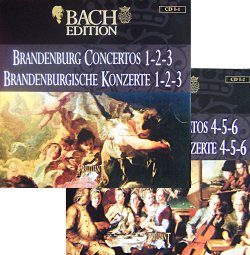
bach: brandenburg concertos
The first section of the Bach: Complete Works on CD are Orchestral Works and Chamber Music, and the first two CDs in this section are the six Brandenburg Concertos. They're performed by Musica Amphion, a Dutch baroque orchestra conducted “from the harpsichord” by Pieter-Jan Belder, and were recorded in May and June 2006. Although I’m not an expert, I can’t find anything in the recording or playing to complain about. All the instruments are bright and crisp and there are no sound artifacts I can hear. Occasionally I can hear someone playing a wind instrument breathing, but I don’t think that’s unusual in recordings of small groups of musicians.
All together, the concertos are very different from each other, and none use the same set of orchestral or solo instruments. The variety in instrumentation, different musical styles, and the unique flavors make them really entertaining to listen to. Each one has something to recommended it, something that sets it apart from the others. I think it’s an excellent way to start off the collection.
Concerto Number 1 in F major, BWV 1046
Solo instruments: oboe, violin piccolo, horn.
Other instruments: two violins, viola, cello, basso continuo, harpsichord.
I wasn't very familiar with this concerto, but I've now listened to it more than any of the others because it’s the first one and I keep starting there and not finishing the whole set. The third movement is especially impressive with all the solo instruments charging in and out. One thing that surprised me is the strong rhythm in the piece (the whole set of concertos, really). I don’t usually associate toe-tapping with classical music (Waltzes excepted), but here it’s pretty strong in places.
Concerto Number 2 in F major, BWV 1047
Solo instruments: trumpet, oboe, recorder, violin.
Other instruments: two violins, viola, cello, basso continuo, harpsichord.
From the very beginning of the second concerto you know you’re listening to something very different because the instrumentation is so different, featuring a trumpet right out front. The second part is quieter and the conversational interplay between the recorder, oboe, and violin is very clear if you’re listening for it. The final part returns to the strong solo trumpeting from the first part. I don’t know whether Musica Amphion uses a traditional valveless trumped or not, but it sounds like it’d be difficult to play even on a modern trumpet. The recorder really compliments the trumpet in this part, sometimes mirroring the trumpet, and sometimes as a counterpoint.
Concerto Number 3 in G major, BWV 1048
Instruments: three violins, three violas, three cellos, basso continuo, harpsichord.
The third concerto is one I’ve heard a lot of in the past, and the melody in the first part is very familiar. I remember it as being played more slowly than what’s recorded here, but the rapid pace makes it seem more urgent and emotional than it would played slower. It really moves along, and has several very dramatic sections. This one only had stringed instruments, which is another variation from the previous pieces. There are parts that seem like solos, but the group is playing together and supporting the overall melody a lot more than in the first two concertos.
Concerto Number 4 in G major, BWV 1049
Solo instruments: violin, recorder.
Other instruments: recorder, two violins, viola, cello, basso continuo, harpsichord.
The fourth concerto is another familiar one, but I don’t think the versions I’ve heard in the past used the recorder. Bach apparently wrote “echo flutes” on the score, which is commonly interpreted to be the recorder, so I’m not sure what instrument I’ve heard in the past. The solo recorder, and the light and whimsical nature of the music brings a happy Disneyesque medieval countryside (Pylea, perhaps) to mind.
Concerto Number 5 in D major, BWV 1050
Solo instruments: traverso (modern flute), violin, harpsichord.
Other instruments: violin, viola, cello, double bass.
The fifth concerto was thought to have been written both to show off Bach’s new harpsichord, as well as for a competition with another composer and organist Louis Marchand, who didn’t show up for the competition. It’s also one of the first harpsichord concertos. The flute solos are quite prominent, but at times the harpsichord takes over completely with no other instruments playing. It’s a good opportunity to hear what a harpsichord really sounds like because it’s in the background for the rest of the concertos, and I’m far more familiar with classical music played on modern instruments where the piano takes it’s place. There are obvious differences in tone and richness between the harpsichord and piano, but one thing I can hear in the harpsichord is that the two hands seem to be able to separate their parts more clearly. During the harpsichord solo near the end of the first part, it really sounds like two people playing, and I think they’d blend together on a piano.
The second movement has just the solo instruments playing, and it seems thinner and less interesting than the rest of the concerto, which makes me wonder what Bach’s other chamber music is going to sound like and whether I’ll be able to appreciate it. Luckily the goodness returns in the third movement. Still, this one is my least favorite of the bunch.
Concerto Number 6 in B flat major, BWV 1051
Solo instruments: viola, viola da gamba, cello.
Other instruments: base, cembalo, harpsichord.
The sixth is another concerto that has only stringed instruments, but it’s unusual because it has no violins and so the sound is deeper and more open. I’m not sure if it’s the instrumentation or the recording here, but this concerto sounds like it’s on a larger stage than the previous concertos. The overall effect of the music and instrumentation makes it seem more serious and mature than the other concertos, and really expands the variety of the entire set.
Conclusions? Since the Brandenburg Concertos are so popular, I haven’t discovered anything new here, but listening to them more critically and with an eye toward what each instrument is doing has significantly improved my appreciation of them.
I got some of the information for this post from the Wikipedia page for the concertos, as well as Benjamin Chee’s introduction. As I mentioned in my introduction to this listening project, I have no particular expertise in classical music, so I’m hoping there will be enough information on the Internet to lead me when I’m not sure what I should be paying attention to.
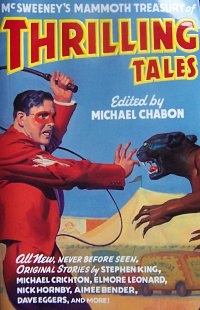
mcsweeney’s quarterly concern #10, michael chabon (ed.)
I’ve given up the monthly book reports in favor of a post every time I finish something. I think it’ll give me a better chance to write more about each book, and my memory will be fresher when I do it. I won’t have a public record of what I’ve acquired each month, but the book queue sidebar gives a good view on what I’ve got (the un-italicized titles) and haven’t yet read.
McSweeney’s Issue 10 (reprinted by Vintage with the proceeds going to support 826 Valencia) is a collection of short stories, but rather than the typical “contemporary, quotidian, plotless, moment-of-truth revelatory stories” (to quote Michael Chabon’s Introduction), the stories are all attempts by the writers to revive the lost art of writing genre short fiction. It’s quite a list of authors too, including Chabon himself, Nick Hornby, Michael Crichton, Dave Eggers, Stephen King, Elmore Leonard, Harlan Ellison, Rick Moody, Neil Gaiman, and others I’m less familiar with.
My favorites include Elmore Leonard’s story about a young man becoming a U.S. Marshall, Kelly Link’s strange story about cat skins and witches, Nick Hornby's take on an end-of-the world coming-of-age story, and Michael Moorcock’s 1930s detective fiction about the murder of Hitler’s half-niece. Rick Moody has an interesting pseudo-time travel story that didn’t grab me enough for me to completely follow it, but it was very interesting and I’ll have to re-read it again to see if I can figure it out.
Some may have suffered in my eyes because I wasn’t enamored of the genre they chose. Despite Geek Love and the first season of Carnivàle, I don’t like carnivals that much, which made Glen David Gold’s carnival story awfully dull. My least favorite parts of Cloud Atlas (itself a work of genre fictions) were the first and last parts, similar to the Jim Shepard story and the “survival / man on the run” story by Carol Emshwiller. Maybe Gold, Shepard and Emshwiller succeeded with fictions I'm just not that fond of.
At the same time, some of the best stories in the collection were the ones that didn’t stray too far into pulpy genres. Dave Eggers’s mountaineering story and Laurie King’s backwoods cabin tale were enjoyable less for the plotting and occasional dips into the genre pool, and more for the fully fleshed out characterization, and the human emotions in evidence.
So, what can the collection tell us about genre fiction and it’s place in the short story world? For me, not a huge fan of short stories to begin with, it’s clear that there’s room for all kinds of fiction, and there’s no reason to reject a story because it’s got themes further from our own, more mundane, experience than usual. I enjoyed both the really pulpy fictions in the collection, and those that were more conventional; and I was bored with quite a few of the stories in each category as well. If Chabon keeps writing great genre novels like The Yiddish Policemen’s Union, maybe there will continue to be room for all sorts of stories in the “Literary Fiction” section at the bookstore.
